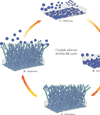Candida albicans biofilms: development, regulation, and molecular mechanisms
- PMID: 26806384
- PMCID: PMC4860025
- DOI: 10.1016/j.micinf.2016.01.002
Candida albicans biofilms: development, regulation, and molecular mechanisms
Abstract
A major virulence attribute of Candida albicans is its ability to form biofilms, densely packed communities of cells adhered to a surface. These biofilms are intrinsically resistant to conventional antifungal therapeutics, the host immune system, and other environmental factors, making biofilm-associated infections a significant clinical challenge. Here, we review current knowledge on the development, regulation, and molecular mechanisms of C. albicans biofilms.
Keywords: Biofilm; Candida albicans; Fungi; Microbial community; Pathogen; Transcriptional regulation.
Copyright © 2016 Institut Pasteur. Published by Elsevier Masson SAS. All rights reserved.
Conflict of interest statement
C.J.N. is a co-founder of BioSynesis, Inc., a company developing inhibitors and diagnostics of
Figures


References
-
- Kolter R, Greenberg EP. Microbial sciences: the superficial life of microbes. Nature. 2006;441:300–302. - PubMed
-
- Jass J, Surman S, Walker J. Medical biofilms detection, prevention, and control. Chichester, UK: John Wiley & Sons, Ltd; 2003.
-
- Hall-Stoodley L, Costerton JW, Stoodley P. Bacterial biofilms: from the natural environment to infectious diseases. Nat Rev Microbiol. 2004;2:95–108. - PubMed
Publication types
MeSH terms
Grants and funding
LinkOut - more resources
Full Text Sources
Other Literature Sources

